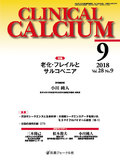Japanese
English
- 有料閲覧
- Abstract 文献概要
- 1ページ目 Look Inside
- 参考文献 Reference
インスリンとIGF-1のシグナルを伝達する下流分子は共通な部分が多く,骨格筋においてはその量を維持する方向に作用する。一方で,インスリン抵抗性やIGF-1濃度低下は,老化に伴い両シグナルの作用低下を来たし,これがサルコペニアの病態形成に寄与しているものと考えられ,また治療標的となる可能性も想定される。またサルコペニアは,全身の老化現象であるフレイルとも密接に関連しており,実際に下等生物においては,インスリン/IGF-1シグナルが個体寿命に影響を及ぼすことが知られている。しかしながら,ヒトのフレイルの病態形成におけるインスリン/IGF-1シグナルの役割については,十分明らかでなく,今後の知見の集積が待たれる。
Insulin and IGF-1 share many of the downstream molecules involved in the signal transduction, and cooperatively maintain volume of skeletal muscle. Along with aging, however, insulin/IGF-1 signaling is impaired, mainly due to insulin resistance and lowered IGF-1 levels, which is thought to promote the development of sarcopenia, and thus they are among the promising therapeutic targets. It is also known that sarcopenia is associated with the development of frailty, one of the phenomena of systemic aging. Actually insulin/IGF-1 signaling is known to affect longevity in lower organisms, but in humans, little is known about roles of the signaling in the development of frailty, and further investigation is needed.



